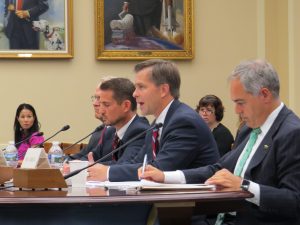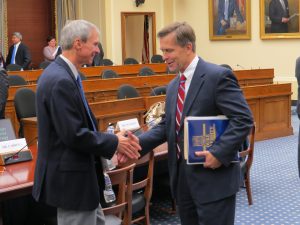In a previous post, we broke down the Obama Administration’s Fiscal Year 2017 (FY17) budget request. This, the second in a series discussing how the federal government funding process works in theory and practice, and why it matters to Duke, we’ll take a closer look at another critical step in the funding process: Congressional appropriations.

Each spring Congress begins the process of fulfilling their most basic duty: funding the federal government. This is appropriations season, when Congress takes the Administration’s budget request and turns that into law, setting the funding amounts for each department and agency that depend upon discretionary funding for the upcoming fiscal year.
For a quick review, the discretionary budget accounts for 30 percent of the federal budget and covers most of the federal programs from which Duke receives money. These include research and student aid, along with most military, workforce training, and other education programs.
To understand what is going on this year and how that will impact funding to Duke, it is important to first know how the appropriations process should work. But first, some context: the first appropriations act, passed by the First Congress in 1789, was 13 lines long and provided $639,000 to fund the government. This years appropriators are working to provide $1.07 trillion for FY17 operations.
At their most basic level, appropriations bills move through the same legislative process as other bills: introduction in subcommittee, amended in committee, debated on the floor and passed by the full chamber.
There are some unique requirements for appropriations bills: first, that the bills must only allocate as much funds as that year’s Budget Resolution authorizes; and second, appropriations bills are strictly funding measures, meaning these bills can’t change existing law or create new programs.
For appropriations bills, of which there are 12, the House and Senate Appropriations Committees are where most of the action takes place. To start the process, the Chairman of each Appropriations Committee provides a top-line number for each bill to the chairman of the subcommittee responsible for that piece of the federal budget.
The twelve subcommittees are then tasked with drafting a bill that includes line-by-line funding numbers for a collection of federal departments or agencies. These numbers are guided by the Administration’s proposals and the previous years funding levels, but subcommittee members also take expert advice, from groups like Duke, and collect input from other members of Congress.
Once the full House and Senate have passed their respective appropriations bills, leadership forms a conference committee with representatives from both chambers that are charged with reconciling the bills — in other words making sure the two bills passed by the chambers are the same.
So that’s it, right? Pretty straight forward. Except it isn’t. Or it hasn’t been since 1996, which was the last year Congress passed all twelve appropriations bills before the start of the new fiscal year (Oct. 1). Since then, figuring out whether or not a program has been funded, and at what level, has gotten more complicated.
Say you have a research grant, funded by the National Science Foundation, which in turn is funded by the Commerce-Justice-Science appropriations bill (don’t ask why these three go together). And this year, Congress hasn’t managed to pass CJS appropriations and it’s getting toward the end of September.
A couple of things can happen: Congress can pass a short-term funding bill, called a continuing resolution (CR), for all departments, including the NSF, they haven’t funded through appropriations bills. These CR’s often continue the funding levels of the previous year (or a percentage thereof), meaning proposed funding increases do not take place.
Or, Congress could decide to pass a bill called an omnibus, which includes several appropriations bills and the kitchen sink, again relying upon previous year’s funding levels to ease negotiations and passage.
Or Congress could fail to pass any appropriations bills by a set deadline, leading to a government shutdown. In that case, the federal government operates only essential services, which typically does not include activities related to the research enterprise.
The dependence on CRs and omnibuses for year-to-year funding has resulted in increased uncertainty in the both timing and availability of federal funding, which can have wide ranging impacts at Duke. Agencies may be forced to delay funding decisions for several months until a final appropriations deal has been signed into law, which can lead to a gap in funding for researchers and labs. During final negotiations, a proposed increase for research program that had been approved earlier in the process could be diverted to another program to help ease passage of the final bill.
For this year, Congress has an even shorter window to pass appropriations bills. The House failed to pass a Budget Resolution, which meant the Appropriations Committee had to wait for the May 15 deadline established in the 1974 Budget Act, to introduce bills on the House floor. And between the Presidential nominating conventions and annual August recess, the House has less than 40 days of votes scheduled between June 1 and Oct. 1 and eleven bills left to pass.
Suffice it to say, it will be an interesting process to watch and the Office of Government Relations will continue to update as the moves forward through the DC Digest.









